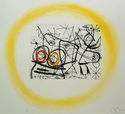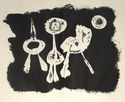
19th, 20th & 21st Century Fine Prints
707-546-7352 · fax 707-546-7924 · web: www.annexgalleries.com · email: artannex@aol.com
Joan Miro Biography
Joan Miro
Spanish
1893–1983
Biography
Joan Miro, painter, muralist, printmaker, sculptor and ceramicist, was born in the Spanish port city of Barcelona on April 20, 1893. Coming from a family of goldsmiths and watchmakers, he was given drawing lessons from a very early age with the the hopes that he would follow in his familial footsteps. However, when he was of age, he asked instead to enroll in the art academy La Llotja de la Seda to pursue painting - allowed by his father only if he was to take business classes as well. Miro agreed. After graduation in 1910 he enrolled at the Cercle Artistic de Sant Lluc (Barcelona), and the studio of Francese D'A. Gali Fabra. He found great inspiration in the work of Vincent Van Gough, Paul Cezanne, and leading modernist art movements such as Cubism, Fauvism, and Surrealism, styles that were still controversial at the time in many cities. Along with several peers he founded the Agrupacio Courbet, an artist's collective championing newer, edgier art movements and rejecting classicism.
His first exhibition participation came in 1918 at the Galeries Dalmau, Barcelona. His works, now referred to as dreamscapes and poetic realism, pulled from the rural landscapes and interiors of his childhood, seen through the fractal lens of Cubism but retaining the saturated colors of his Fauvist heroes. The work received outright ridicule due to its non-traditional style, and some were defaced. Undeterred, he traveled to what was then considered the center of the art world, hoping to meet the artists, writers, and intellectuals of the avant-garde who were interested in a new way of thinking. He arrived in Paris in 1919.
Miro officially became a Parisian resident in 1921, the same year he mounted his first solo exhibition at the Galerie La Licorne. This show was met with critical acclaim, praising what would later be called his "Catalan Fauvism" period, and he began to establish his reputation among the ranks of leading modernists such as Pablo Picasso and Max Ernst. In 1924 Miro joined the circle of the Surrealists in 1924 but, uncomfortable with confining his style to any one label, he never fully committed himself to the movement and was eventually excommunicated. He would remain friends with Andre Breton, who would later promote Miro's work.
He expanded his technique to include collage and printmaking, and frequently traveled, including to Holland and summering in Spain. In the early 1930s, Pierre Matisse opened the influential Pierre Matisse Art Gallery in New York City and chose to represent Miro there, introducing his work to the U.S. for the first time.
It was between the onset of the Spanish Civil War and the Second World War that his work began to take on a more political bent, and in 1937 he was commissioned by the Spanish Republic to create a work for the Spanish Republican Pavilion at the 1937 Paris Exhibition. With the invasion of France by Germany nearing, Miro moved from Paris to Normandy with his wife, Pilar, and their daughter, and within one year had to move again, this time returning to Spain in the midst of the war. During this time of upheaval he created a series of twenty-three gouaches, titled Constellations, which would become among the most noted works of his career, displaying a sense of hope and joy in an otherwise dark time.
In 1940 the first monograph of his work was published by Japanese art critic and artist Shuzo Takiguchi, and the following year the Museum of Modern Art in New York mounted a retrospective of his work. In 1947, Miro visited New York and worked at Atelier 17 with Stanley William Hayter, who had moved his famous experimental printmaking workshop from Paris to the U.S. during the war. It was at this time that Miro honed his intaglio printmaking skills and in 1954 he was awarded the International Grand Prize for engraving at the Venice Biennial in 1954. He would go one to illustrate around 250 livres d'artiste using lithography and intaglio. Miro moved into his villa at Palma de Majorca in 1956 and continued to work and exhibit. In 1958 he was given the Guggenheim International Award.
Miro's reputation by now had international reach, and he was commissioned to create works for various institutions around the world. Among these were a series of sculptures for the Maeght Foundation in Saint-Paul-de-Vance, France (1964); the World Trade Center Tapestry, New york, NY (1974); mixed-media sculpture Miro's Chicago (The Sun, the Moon, and One Star), Chicago, IL, among many others. Changes and developments in the political climate of Spain allowed for the first full exhibition of his work in 1978 at the Museo Nacional Centro de Arte Reine Sofia. In 1981 Palma City Council in Majorca established the Pilar and Joan Miro Foundation of Mallorca.
Joan Miro died on December 25, 1982, in Palma de Majorca, Spain and his villa was transformed into the Miro Museum in 1992.
Partially sourced from the Olga's Gallery website.







